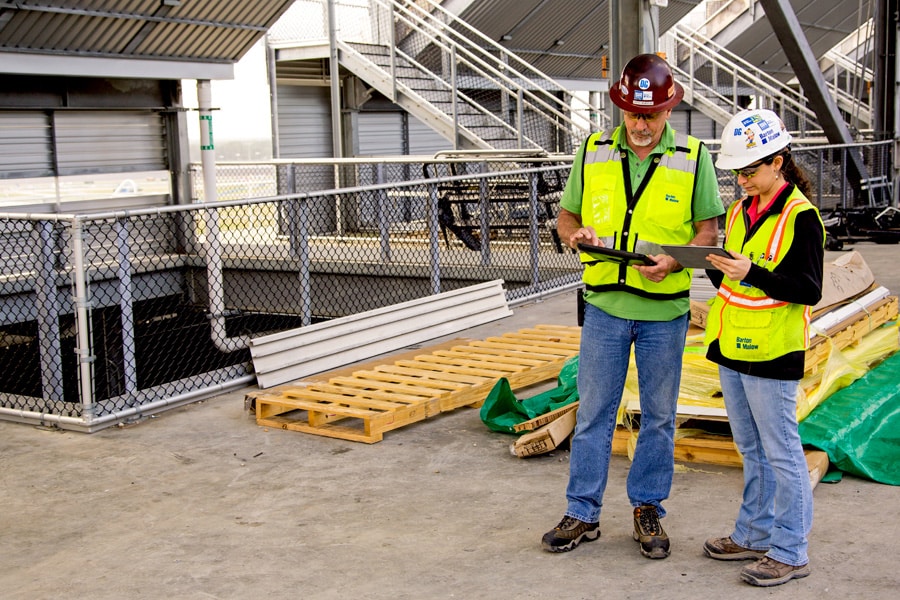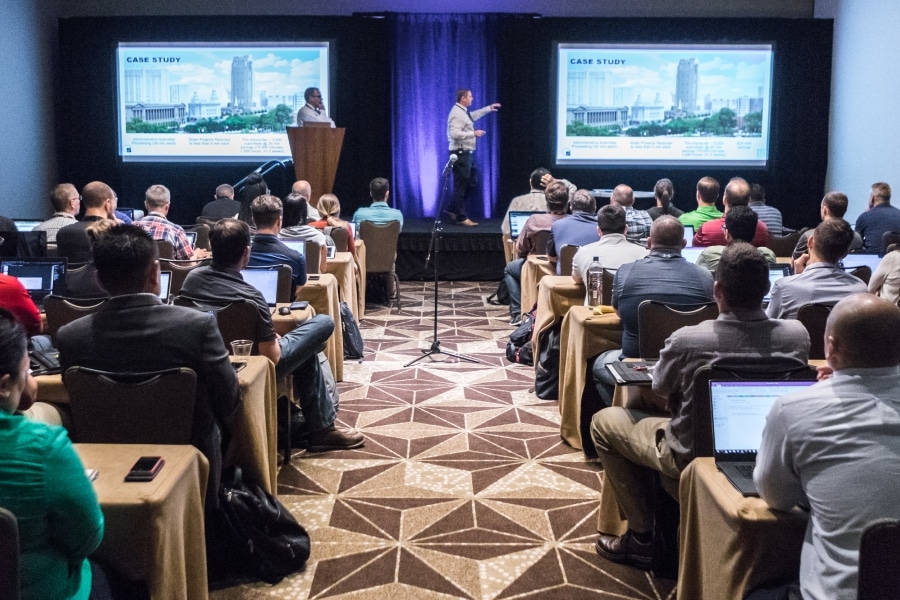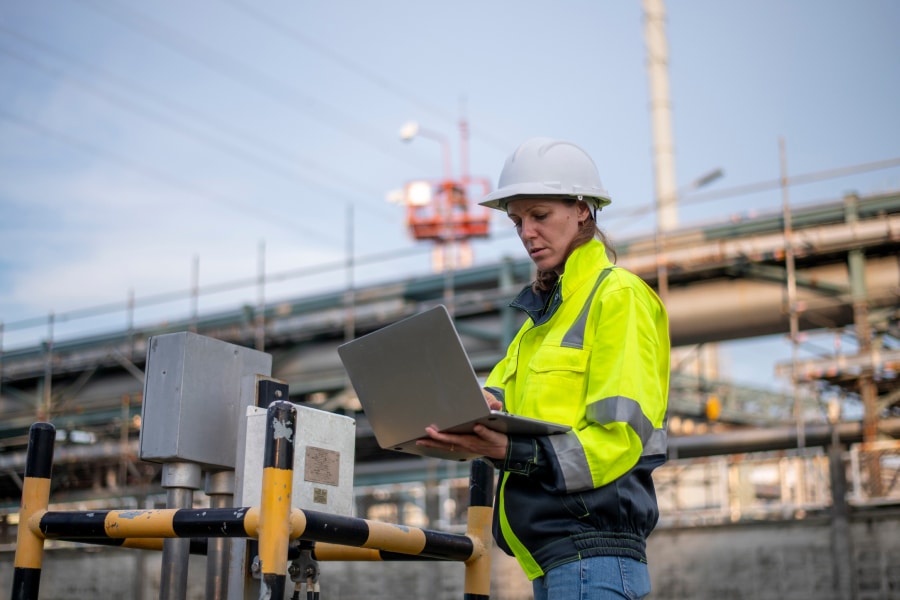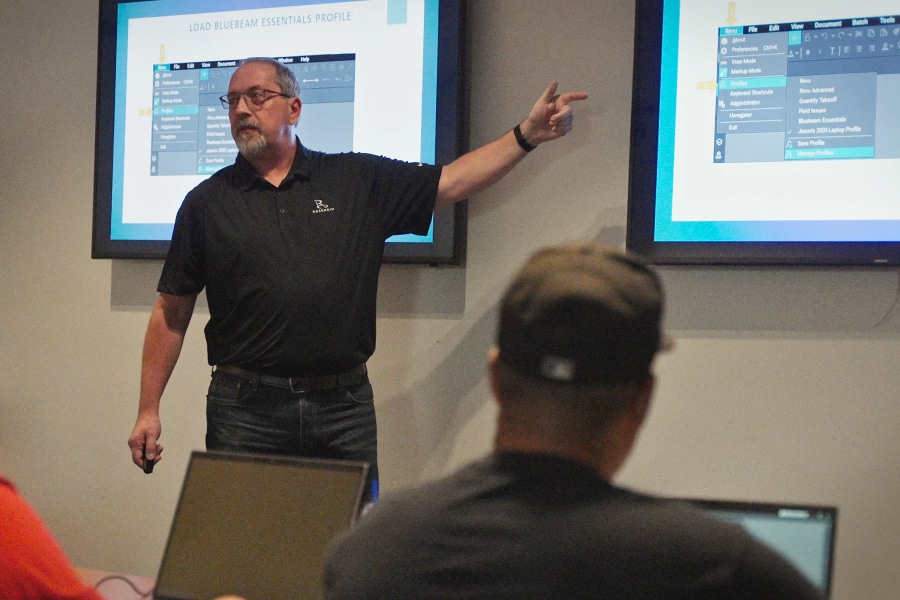“The AEC industry is broken,” says Jason McFadden. Intrigued, we went to investigate how McFadden is uniting diverse generations of expertise on a massive jobsite to affect cultural industry change.
The insider Q&A scoop below is lightly edited for clarity from the video version above.
Speakers
Jason McFadden, E.I.T., LEED AP | Project Director, Barton Malow
Sasha Reed | VP Strategic Development, Bluebeam
Sasha: So Jason, we’re sitting here in Daytona International Speedway® on the DAYTONA Rising project. I’ve spent the last couple of days walking the jobsite, talking to your crew and people, really getting a sense for what’s been pushing this massive project forward.
There’s been some really great conversations and a lot of common themes, among them which I think are unique—symbiotic mentoring, technology-enabled workforce and other concepts I don’t think are widely talked about. This made me curious about you, because your name came up over and over. I thought maybe you and I could sit down and get to understand a bit of the person behind the project: How did you get to this project? What’s brought you to have the perspective you have?
Jason: Timing is everything. I had a project that was ending and this project came about. I’ll never forget where I was when I got the phone call to participate in this project. I was at the airport in Charlottesville, Virginia when our senior vice president called and said, “Hey Jason, would you be interested in helping with this presentation for the Speedway renovation?” The only answer is yes, right? Why would you say anything else? [Laughter]
I knew nothing about the job. I very quickly learned it was a very complex, $400 million renovation project and I thought, Wow—I’ve done $3 million projects, so this should be fun, right? How do you even start to plan for that?
In December 2015, American Construction spending totaled $1.1 trillion.1
Construction has always been intriguing to me. You drive down the street, you see back hoes, front-end loaders, cranes. It’s just one of those industries that drives interest by its very nature.
What I learned in my first six years in the industry was that it’s broken on so many levels. It drives me crazy, having to do things over and over. Like our standard RFI process and our submittal process—why
can’t we get it right to start? Why must we keep asking and re-asking, or approving something that’s already shown?
The opportunity of this project, this challenge and the role I have on the job allowed me to try some new things. 98% of large projects face cost overruns or delays. Average cost increase: 80%. Average time delay: 20 months2
I was empowered by the company to say, “We can’t do business like we have always done business, so let’s figure out a different way, and not in your own bubbles—make sure you’re communicating.” I got a lot of influence from other team members who suggested, What if we do this? What if we do that? And the rest is history with where we are today.
Sasha: It’s interesting saying that the industry is broken. I hear that so much from so many young, ambitious, passionate people within the industry. But thinking about you, it’s interesting you got to the point where you said, “The industry’s broken, why do we have to start from scratch every single time? Hey! I’m going to do a project bigger than anything I’ve done before, that’s the solution!” [Laughter]
Jason: It’s one of those things…You bang your head against the wall…Why would you start [trying to change] on the largest project? [Laughter] It was just an opportunity, truly an opportunity. I was driven to help fix, help change things, hopefully for the better. We didn’t know until we tried, and we had a lot of sleepless nights getting to that point of trying to pull back all the layers.
Internally, I had a lot of support. We were set up with our Systems Group, a team that came from jobsites, which really made my life a lot easier when I talked to them about, “What if we used this software, that software, this process?” These things were high up among the goals of what we needed to change.
80% of execs agree that knowledge-sharing across roles is crucial for growth. Only 25% claim their organizationis is effective at this.3
There are a lot of things we’ve done here [on the DAYTONA Rising project], like the symbiotic mentorships that you talked about, Sasha, that was even important to me as an intern. We had a mentoring program where you would get paired with someone who had been in the industry for a while, and they could help teach you and you could be a sponge, take it all in.
The symbiotic mentorship on this project that’s worked really well is a sponge both ways: Our younger engineers get to teach and learn how to listen and have patience, which is important when in a mentorship relationship with a superintendent who may be learning about technology tools [for the first time], that will hopefully make their lives easier, but may present the ‘years of experience barrier’ for the engineer to overcome. And vice versa: our superintendents love to teach; they’re just teachers at heart. It’s fun to sit back and watch the sleepless nights come to fruition.
Sasha: That’s something very interesting that you said: “Superintendents love to teach.” If we’re really honest and transparent about the state of the industry and talking about it being broken, some of the most difficult parts are getting buy-in from those who are really resistant to change. How did you find this sense where the superintendents are loving to teach?
Jason: It’s absolutely experience. My first four years in the industry, the attitude was, You’re going to use this, you’re going to use this software, and force it down their [superintendents] throats, and if they didn’t pick up on it, then move on to the next topic. That just doesn’t work. I mean, I don’t like to be forced into doing anything. 66% of workforce are Gen Xers and Boomers. By 2020, they’ll represent only 54% . Almost half the American workforce will be Millennials.4
When you take a step back, you understand that we’re invading their world. That’s what we’re doing with everything we’re talking about, whether it’s process, the technology toolbox, whatever that may contain. Accept that you can take a step back, try to understand their world and what makes them tick, because to ultimately get buy-in, you need mutual respect. You need trust, you need mutual respect. This takes time and a lot of patience.
And so here on the jobsite, this has been top of mind in the onboarding conversations we had early on. And it’s exciting for me to hear that this has come out over the last couple days based on your interactions, Sasha. Because that means we’re doing something positive, that there’s a culture change happening, and it hasn’t happened overnight—it’s taken a lot of hard work and a lot of determination.
Retention rates are over 20% higher for mentorship employees, equaling $6.7M in savings.5
All superintendents are passionate, much more passionate than I am. They’re so passionate about what they do; they love building, they love this industry, and it’s what they’ve done. A lot of them grew up physically doing the work and now they’re overseeing and managing it. So when they get to teach and talk about their experiences and we can be a sponge and learn from that, and hopefully in turn provide them a tool that allows them to be more efficient and to better communicate the information they’re trying to say, it’s pretty special.
Sasha: 78% of Millennials say access to technology they like makes them more effective at work.6
It’s interesting, the double-edged sword is if you’re too technically savvy, you’re going to be dismissed immediately as, “Obviously it’s easy for you, Jason, this is your generation, you grew up with this.”
Jason: I may have actually heard that once or twice! [Laughter]
Sasha: So how do you walk that fine line of being the technology expert—obviously Barton Malow believes in your opinion of technology and how you apply it—and yet being in the place of, “Hey, I have to learn it too, guys!” How do you balance that?
Jason: Well one, you’re not always right. You’re never always right, anyway. With everything we do, just being patient. Pick your battles. Lose some battles, even if you think you’re right, because that’s how you build mutual respect and trust. Be a listener. Let them do. If I’m talking about a superintendent, let them show me, don’t show them and don’t tell them, but rather let them show me how they normally do it and then give thoughts on how it could be done differently, depending on what the topic is.
It’s learning what makes each person tick, it’s not an engineering calculation. It’s that class that no one wanted to pay attention to, that Psychology 101 class. But it’s turned out to be really, really fun. Some of the best projects ever built in the industry weren’t run by engineers or architects or construction-minded people, they were run by psychology-type of people because that’s our job at the end of the day: To figure out how to get this team coming from all these different backgrounds to work together. It’s a PhD within itself! But it’s fun. It takes a lot of time to get to know your team to be able to do it.
Sasha: I’m curious to know, what do you see as the next major challenge you’d like to throw yourself into? What do you want the next phase for yourself and for your project teams to be?
Jason: For me, it’s that we’ve been successful here at Daytona on this cultural change that we’re talking about and now the domino effect internally is happening. And we build cool projects! That’s the cool part about Barton Malow. I mean, we’re sitting here in Daytona International Speedway, the Super Bowl of racing.
It’s continuing to positively influence more and more teams and get better at how we work together. It’s not necessarily about finding the right piece of steel or the right brick material. It’s how we communicate, how we are transparent with information, and ultimately how we build not only better projects, but better teams.
Sasha: It’s inspiring meeting you. Thanks for sitting down with me. And thanks for giving me carte blanche to walk around the jobsite wearing a hard hat and PPE!
Jason: Absolutely. And don’t forget to come back and watch cars turn left for four hours! [Laughter]
Stay tuned for more Barton Malow stories racing toward StrXur soon!
- 1. US Census Bureau, “Value of Construction Put in Place” Survey Monthly Estimates, December 2015
- 2. McKinsey & Company, “The construction productivity imperative,” July 2015
- 3. McKinsey & Company, “Mapping the value of employee collaboration,” August 2006
- 4. UNC Kenan-Flagler Business School, Whitepaper “Maximizing Millennials in the Workforce,” 2012
- 5. UNC Kenan-Flagler Business School, Whitepaper “Maximizing Millennials in the Workforce,” 2012
- 6. PwC, “Millennials at Work: Reshaping the Workplace,” 2011











